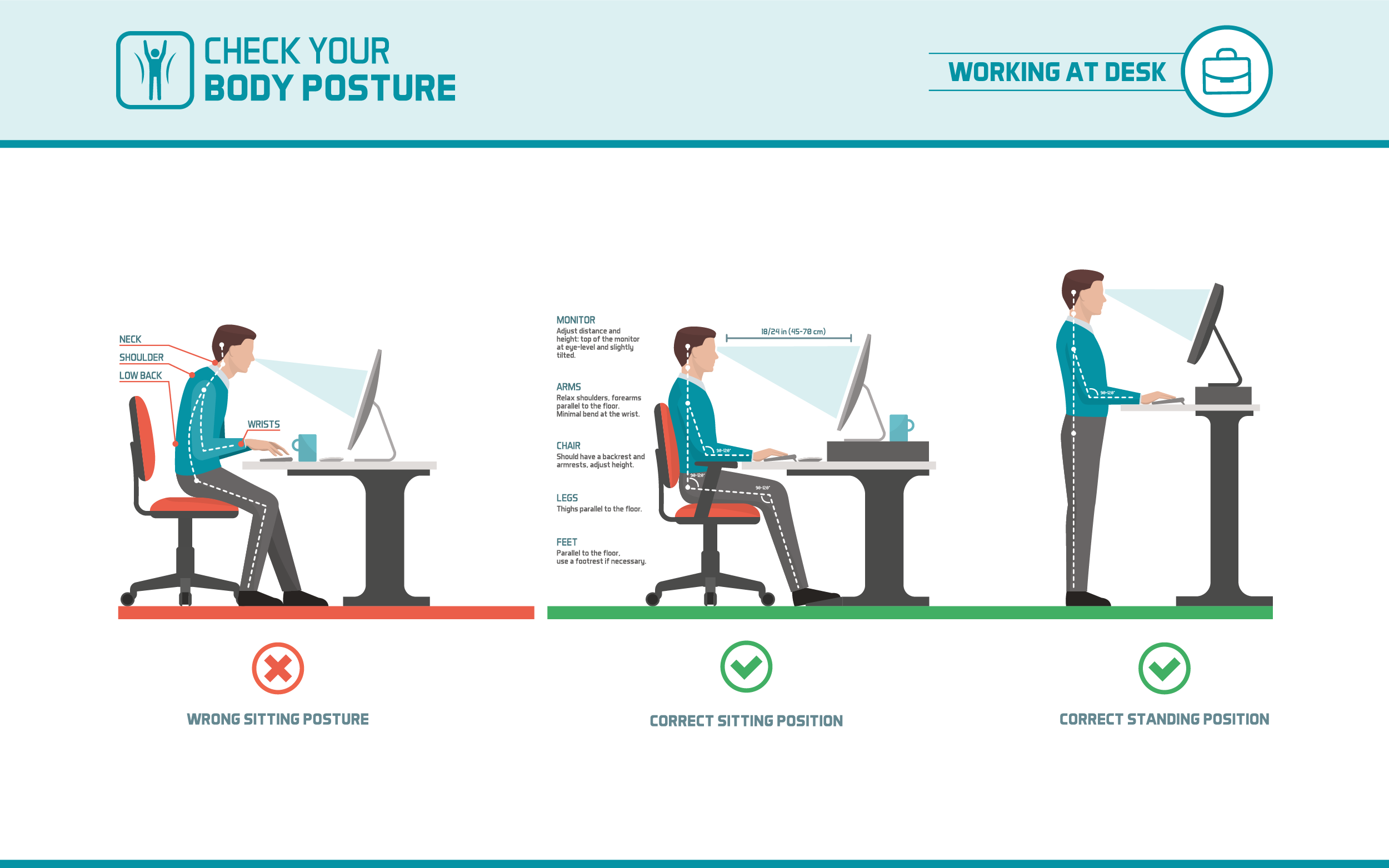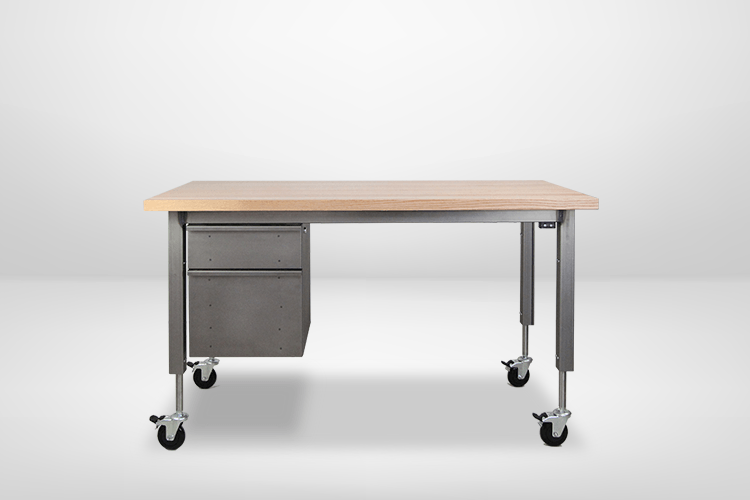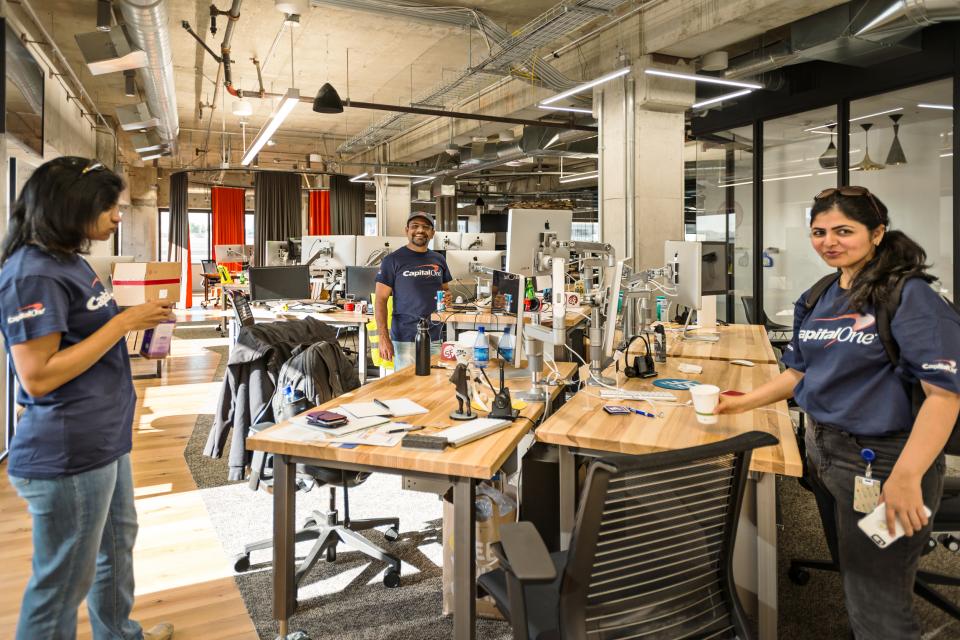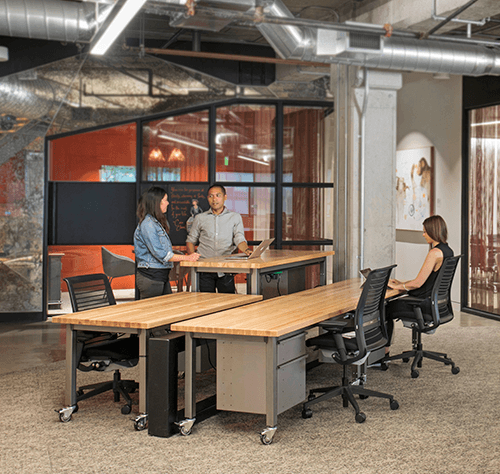At its core, the field of ergonomics is the study of how to help people perform better — at work, home and play. Today we’ll look at some of the ways you can use ergonomics in the workplace to improve the performance and well-being of your employees in the office.
Have you ever really looked at people? Really studied them in detail?
The industrial designer Henry Dreyfuss did, starting back in the nineteen thirties.
Dreyfuss and his firm, Henry Dreyfuss and Associates, applied new techniques in the study of human factors and ergonomics in the workplace by systematically measuring and quantifying variations in height, weight, girth, range of motion, range of vision, and so forth among the contemporary population of modern consumers. (This type of study, known as anthropometry, was originally developed by anthropologists to study ancient civilizations.)
In 1955, Dreyfuss published Designing for People, which outlined the principles of ergonomics that guided their firm during the development of many iconic product designs. These include the early Hoover upright vacuum cleaner, and the ubiquitous round Honeywell thermostat — as well as later products, such as Princess and Trimline telephones and the origami-inspired folding Polaroid SX70 camera.
Dreyfuss Publishes His Seminal Work in Ergonomic Solutions: The Measure of Man
In 1959, Dreyfuss followed up Designing for People with the seminal work, The Measure of Man.
As part of their research, Dreyfuss Associates divided the male (nicknamed “Joe”) and female (nicknamed “Josephine”) American consumer population into size percentiles, ranging from 1 to 100. They then created human outlines, or “templates,” to represent each of the percentiles, from the smallest woman to the largest man. With this information in hand, industrial designers could evaluate product designs on the drafting table using real-world data directly from Dreyfuss’ human templates.
How do these human templates work in practice?
Take something we’re all familiar with — car design for example.
The role of ergonomics can be easily understood in the context of designing new car interiors, which have to accommodate both the smallest female and largest male drivers.
Using Dreyfuss’ graduated human templates, designers developing a car interior would be able to quickly identify what adjustments would be needed for a small woman from the 2nd percentile to see the road ahead. The same goes for the larger man. Designers can easily overlay a Dreyfuss template representing a 99th percentile man on top of a proposed design to visualize, for example, how difficult it would be for him to fit behind the steering wheel or to avoid hitting his head on the roof of a low-profile sports car.
The Measure of Man is still considered the ergonomics “bible” for industrial designers and human factors engineers today. It’s been updated over the years to incorporate new scenarios in office ergonomics, such as office workers using computer monitors and keyboards at their desks — as well as to account for the increasing height (and, unfortunately, weight) in today’s population.
How Do Your Office Ergonomics Measure Up?
It’s been almost 60 years since the original edition of The Measure of Man was published — and, no doubt, there have been quite a few changes in office ergonomics during these intervening years.
In comparison to earlier generations, today’s office workers tend to be responsible for producing their own research (thanks to computer software and the internet) as well as typing up and printing their own documents (rather than relying on dictation or a typing pool.)
As a result, today’s workers often find themselves spending hours and hours staring at a computer screen, typing on a keyboard and manipulating a computer mouse.
If we don’t pay attention to proper office ergonomics, these repetitive work habits can have a negative impact on our physical health. But, rather than focusing on the negative (and sounding like we’re ‘nagging’), let’s point out the top five benefits of implementing proper ergonomics in the workplace:
1. Ergonomics Helps Ensure Physical Safety in the Workplace

Most accidents occur suddenly and unexpectedly, but proper ergonomics in the office can help prevent many types of accidents.
As we’ve written about before, tripping and falling are among the leading causes of workplace accidents. To prevent them, your Formaspace Design Consultant can help you design and specify custom storage solutions for your office – so that everything has a place and everything is in its place – which can significantly reduce the chance of tripping and falling accidents.
It’s also critical to keep all power cords as well as computer and networking cables up and away from the floor, which is why we offer built-in power-systems across our office furniture lines. Little details like these can make a big difference in worker comfort and safety. Even the choice of leg design on tables and desks can reduce trip hazards. Talk with a Formaspace Design Consultant who can help review all your options for creating a safer, more ergonomically fit work environments.
In addition to avoiding trip hazards, ergonomic analysis can also help you set safe weight and size limits for employees picking up and carrying heavy objects by hand – a common hazard in your office’s shipping and receiving department.
For example, when it comes to lifting heavy or awkward items, Formaspace can provide custom, hydraulic-powered lifts that are built-in alongside packing stations or other work surfaces where employees handle heavy items. Using lifts and other safety devices we recommend will help prevent on-the-job accidents and injuries.
2. Proper Ergonomic in the Workplace Can Prevent Musculoskeletal Disorders (MSDs)
In addition to helping prevent injuries due to sudden exertion (due to tripping/falling or lifting heavy objects), proper office ergonomics can help prevent other types of common Musculoskeletal Disorders (MSDs) that can develop in the office, such as Tendonitis and Carpal Tunnel Syndrome.
These types of injuries can occur when workers repeat the same motions over and over again, particularly when maintaining an improper or awkward posture.
To help prevent MSD-type injuries, you need to provide employees with well-fitted, fully-adjustable chairs as well as ergonomic work surfaces, such as our new Weldmarx™ line of height-adjustable workstations, tables, and desks.
Workers using Weldmarx desks and workstations benefit by changing their positions (from sitting in chairs to standing while working) throughout the day, which can help minimize the hazardous effect of repetitive motions.

It’s also highly recommended to bring in an ergonomics expert to assist employees who need help in establishing good posture, making proper seating adjustments, and positioning their monitors and keyboards in comfortable, healthy positions.
3. Moving Throughout the Day Can Improve Long-Term Health and Well-Being
Using a fully height-adjustable desk can provide additional health benefits beyond helping prevent specific Musculoskeletal Disorders (MSDs) — moving around during the day can improve your overall health and well-being in other ways.
As we’ve reported on earlier, there is increasing evidence that sitting all day long at the office can be as dangerous to your health as smoking cigarettes.
Standing while working during parts of the day can help improve your circulation and help reduce lower back injuries caused by long periods of sitting.
We recommend you give one of our new height-adjustable Weldmarx desks a try. Unlike other desks which only lift the work surface, the unique Weldmarx design lifts the entire desk up from the legs, so that your entire workspace (including shelves and drawers) moves up or down as one — making it much more convenient and natural to use.
Your Formaspace Design Consultant can help you determine which Weldmarx table, desk, or work station is best for you, as well as make recommendations for additional ergonomic accessories, such as floating monitor arms that allow you to easily move your computer monitors to healthy positions that reduce glare and eyestrain.
4. The Return on Ergonomic Investments: Enhancing Performance and Motivation
The return on investment (ROI) that you can earn from improving ergonomics in the workplace is significant.
From a pure hard numbers point of view, preventing one serious back injury or a debilitating case of Carpal Tunnel injury will result in significant savings in lost productivity, as well as increased employer health care costs, worker’s compensation claims, and insurance premium increases.
But there is more to the story than that.
In the competitive world of hiring (and retaining) the best talent, your investment in ergonomic solutions for the workplace will not only help you attract employees, you’ll also likely see improved productivity and retention rates.
Today’s employees recognize that they are valued when their employer invests in their well-being and health at work.
And, with improved office ergonomics, employees will feel more refreshed and productive during each and every day at work, which in turn, will have a positive long-term effect on company’s bottom line.
5. Ergonomics Helps Provide Accommodation for Different/Changing Abilities
People come in all shapes and sizes, with a wide range of physical and cognitive abilities.
Thanks to the Americans With Disabilities Act, employers need to provide proper accommodation for those with different needs.
We can help. Formaspace can recommend specific office ergonomics solutions for differently-abled workers, ranging from custom workstation designs to height-adjustable conference tables.
Thanks to the modular design of Formaspace office furniture, it’s easy to reconfigure your existing work environment as your needs change, such as when it’s time to accommodate a new employee with special needs. Our modular furniture can be disassembled and reassembled into new layout configurations using simple hand tools. (If at any time in the future you need additional furniture components or matching replacements, we are just a call away to fill your order.)
Also, if your office runs 24 X 7 with different employees working different shifts, you can reconfigure Formaspace tables and desks on the fly, through a combination of furniture fitted with custom, heavy-duty casters (that can be rolled in or out as needed) and height-adjustable work surfaces (such as those found in our Weldmarx office furniture collection) that move up or down at the touch of a button.
Don’t forget: accommodating differently-abled workers can also provide benefits to your other employees as well.
For example, creating wider pathways for wheelchair access that are clear of clutter can help reduce tripping and falling accidents for non-disabled workers as well. And all employees will benefit from flexible, height-adjustable work surfaces and easy-to-manipulate monitor arms.
Count on Formaspace to Meet Your Office Ergonomics Challenges
Leading tech companies like Google, Capital One, and Twitter come to Formaspace for unique office solutions.
Join the ranks of our Fortune 50 and Fortune 500 customers who depend upon Formaspace to meet their demanding challenges for ergonomic work environments, shipping and distributions centers, laboratory research centers, and more.
Our friendly Formaspace Design Consultants are ready to share a wealth of information with you on how to best organize your space with our custom and semi-custom furniture solutions, all built-to-order here in the USA at our factory headquarters in Austin, Texas.
Make the right move today. Fill out the quick contact form below and a Formaspace Design Consultant will contact you today.
See original post on Formaspace.com


